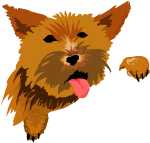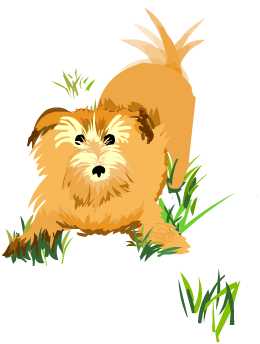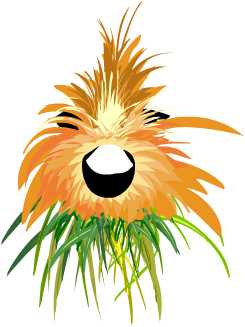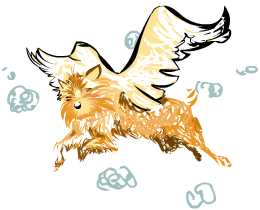|

This article will shed light on those mysterious dog behaviors that humans tend to misunderstand. Why do dogs love to chew our socks? Why do they
eat grass? What are dogs telling us when they wag their tails?
Discover the answers to these questions and
more in... Decoding Dog Behavior.
Telling Tails: Since dogs rarely wag their tails when they are alone, they must be using this gesture to communicate to others. For example, when a dog’s tail wags as it is given food, it is expressing pleasure to its owner. When dogs eat and play alone, they rarely wag their tails because there is no one to see them.
 When a dog wags its tail, surrounding muscles press on scent glands, releasing pheromones that signal the pooch’s age, sex, and social status. Submissive dogs may not wag their tails when frightened because they do not want to draw attention to themselves. When a dog wags its tail, surrounding muscles press on scent glands, releasing pheromones that signal the pooch’s age, sex, and social status. Submissive dogs may not wag their tails when frightened because they do not want to draw attention to themselves.
A high, quickly wagging tail is often a sign of playfulness and intense joy, but can also signal an aggressive dog. A horizontal, steadily moving tail suggests that your dog is closely studying something. If a dog tucks its tail between its legs, it is afraid, and attempting to communicate that it is submissive and does not pose a threat.
Just One Lick: Licking is a very natural activity for dogs. Puppies lick their littermates to groom one another and to strengthen
family bonds. In the wild, puppies will even lick their mothers to stimulate her to give them partially digested food. Adult dogs lick each others faces to show submission, and also affection and friendliness. If a dog licks you, it may be showing that it acknowledges you as dominant, showing its affection, begging for food, and, of course, grooming you.
 Grass Eaters: Eating grass is a normal behavior for dogs, and scientists have several theories as to why: Grass Eaters: Eating grass is a normal behavior for dogs, and scientists have several theories as to why:
Some believe that dogs eat grass because it makes them vomit. If they feel nauseous or have eaten some food that doesn’t agree with them, eating grass will help them clear their stomachs.
Other scientists believe that, like wolves and foxes, grass is a natural part of a dog’s diet… Maybe dogs just like the taste?
Stop, Droppings, and Roll: Scientists believe that rolling in strong smelling stuff, including feces and dead animals, gives predators a huge advantage: their scents are masked from the animals they are hunting. While most pet dogs do not hunt for their supper, their old, smell-loving instincts remain, and they are happy to roll in smelly stuff regardless of what their owners think.
Leg Lifts: Have you ever noticed that male dogs prefer to pee on a standing object, like a fire hydrant or tree? They are placing their scents at nose level, so other dogs can smell it, and the wind can spread it, more easily than if the scent were on the ground. To place their scent at nose-level, small dogs must lift their legs quite high to send their pee to the right spot. Large dogs don’t have to try so hard, and rarely lift their legs as high as their smaller cousins.
 Dreaming Dogs: Have you ever seen a dog twitching, moving Dreaming Dogs: Have you ever seen a dog twitching, moving
its legs, or making noises while sleeping? These are typically
signals that a dog is dreaming!
Dogs tend to dream
for shorter periods of time than humans, but they also tend to move more as they dream. Dogs often make chewing motions, lick, move their feet as though they’re
running, and even bark while in the throws of R.E.M sleep.
Salivating Over Socks: Contrary to popular belief, dogs are not capable of complex emotions like spite and revenge. Instead, when we are away from home, dogs probably play with our favorite possessions because they remember seeing us hold them, and they carry our scents. If a dog misses its owner, it will often do things that remind them of their favorite human… like chew on a favorite pair of sneakers or pillow because they associate them with their owner.
Mind Readers: Through several experiments, scientists have discovered that dogs can read human gestures and sounds far better than chimpanzees and wolves. Even young puppies are tuned in to human cues, suggesting that canine social skills are inherited, not learned. Scientists believe that these social skills evolved as humans domesticated dogs. Over time, humans bred dogs that were most able to understand directions and express their physical needs.

|
